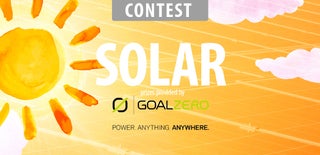Introduction: PV Solar Tracker With ESP8266
I have 3 small solar panel on my yard which powers night lamps, 1 x 20 W and 2 x 10 W.
I've decided to make a solar tracker for the 20W one using the components that I have in my backyard.
The system functionality is as follows:
1. The brain - ESP 8266 board take the current hour from a dedicated php file hosted on my ISP provider. The frequency of accessing the php file is once per hour.
2. According to the scheduled hours the brain command the movement of a DC motor through a H-bridge. At the end of the day reset the panel position.
3. Light on and light off the 12V bulb at scheduled hours through an Arduino relay.
4. Has is own webpage for controlling the DC motor parameters, updating time manually, rotate the panel, light on, light off.
Step 1: Components Used:
A. Hardware
1. ESP8266 NodeMCU devkit.
2. DC roof motor salvaged from an old SMART FORTWO cabrio.
5. Metal frame for the PV panel. I use one from a kids bicycle.
6. Plastic case with tight lid for all the electronic components.
B. Software
1. Arduino IDE
2. Dedicated software, available here
3. Internet connection with wifi router
Step 2: SOFTWARE PART.
The ino files are available here.
You must install Arduino IDE on your computer and made the corresponding settings on it (google Arduino IDE esp 8266). There are a lot of tutorials that teach you how to install ESP8266 libraries on Arduino IDE.
Pay attention that there are some ESP8266 12-E boards that needed to be flashed first. You'll know it if you're unable to upload the sketch from Arduino IDE. Do not waste time with putty, esptool etc. There are of no use until the flashing procedure is done.
The flasher software that you need is available at https://github.com/nodemcu/nodemcu-flasher/. It runs on Windows only I think. There are several videos on youtube with flashing procedure. It is the same for all ESP boards.
One of them is this one.
Open the sketch with Arduino IDE and uploaded it on ESP 8266 board. The procedure is similar to that of Arduino boards.
The web interface could be easily modified. I do not spent much time on it.
Step 3: Final Setup
I've welded the gear of DC motor to the frame.
I've mounted DC motor and the light pole on the metal plate.
I've put the welded gear back to the DC motor.
I've made the electrical connections.
I've powered up entire system.
You may watch it on youtube

Participated in the
Solar Contest 2016

Participated in the
Backyard Contest 2016





![Tim's Mechanical Spider Leg [LU9685-20CU]](https://content.instructables.com/FFB/5R4I/LVKZ6G6R/FFB5R4ILVKZ6G6R.png?auto=webp&crop=1.2%3A1&frame=1&width=306)





